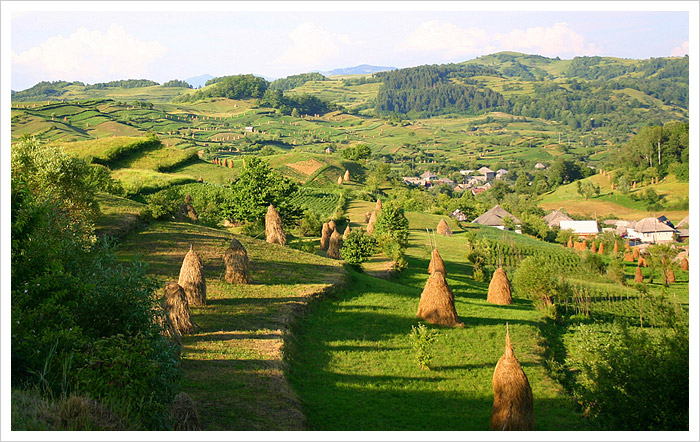
Hay. Beautiful.
Farmers in Transylvania have created a landscape of flower-filled hay meadows.
Can they endure?
By Adam Nicolson (National Geographic)
You can't help but smile as you walk in early summer through the grass-growing valleys of Transylvania. They ooze a kind of sweet-smelling well-being, largely because these valleys in the Carpathian Mountains in the center of Romania contain one of the great treasures of the cultivated world: some of the richest and most botanically diverse hay meadows in Europe. You can find up to 50 different species of grass and flowers growing there in a single square yard of meadow, and even more within reach as you sit down among them. This flowery miracle is maintained not by nature but by nature worked with the human hand. The richness is there only because a meadow stays a meadow if it is mown every summer. Abandoned, it will be filled with scrub in three to five years. As it is, for the moment anyway, Transylvania is a world made beautiful by symbiosis. All day long the smell of the meadows gradually thickens, and as the sun drops, the honey-sharp smell of the butterfly orchids, night scented, pollinated by moths, comes seeping out of the hillsides.
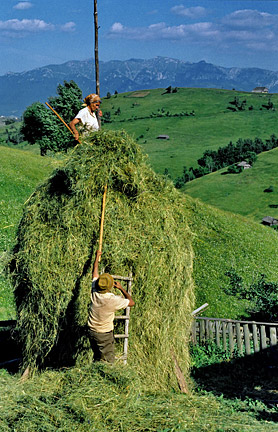
Go for a walk, and you'll find the flowers crowding around your feet. Practically no chemical sprays and no artificial fertilizers—too expensive and distrusted by these poor, small-scale farmers—mean the hillsides are purple with meadow salvia and pink with sainfoin. Globeflowers, a sort of enlarged buttercup, stand in the damper patches like Japanese lanterns. The little burnt-orange hawkweeds called fox and cubs are interspersed with the sorrel and the orchids, the campanulas and the yellow rattle. Hares appear on the track in front of you. In places, the grasses have been roughly crushed and pushed aside—bears have been through here, looking for anthills to raid or fungi to plunder.
But if you go with Attila Sarig—a powerful and articulate 30-year-old farmer from Gyimes in Transylvania—the experience deepens. Sarig, sometimes with a murmured "Aha," pauses now and then to pick the medicinal herbs that grow among the grasses: sorrel, snapdragon, gentian, marjoram, thyme, meadow salvia, all of which will hang and dry in his house or barn for winter infusions. "I know that I make this landscape by what I do," he says.
The ethnoecologists Zsolt Molnár and Dániel Babai have found that among the people of Gyimes anyone over 20 years old can on average recognize and name more than 120 species of plants. Even young children know 45 to 50 percent of species. "It is because they still depend on biomass," Molnár says. "They need to know what it is that is feeding them. Among the people I've surveyed, 72 percent of the visible flora and 84 percent of the botanical cover is known." It's a handmade world, largely unmechanized, too steep for reseeding, so people have come to know exactly what is there. Nowhere else, Molnár suggests, can people distinguish in their local vocabulary such a high number of separate habitats: shady, damp, steep, woody, mossy, and so on. "The average in the world is between 25 and 40," he says. "The maximum anyone has found elsewhere is 100. Here in Gyimes it's at least 148."
There is a powerful chain of connections at work here. In the summer the grass of the pastures feeds the one or two family cows. But in the six-month stretch from mid-November to mid-May, they must remain inside, where the hay provides their only sustenance. Only hay makes keeping cows a possibility, and only milk from cows makes human life viable here. People in Transylvania live on the nutrient transfer from meadow to plate. That is why, in these valleys, hay is the measure of all things.
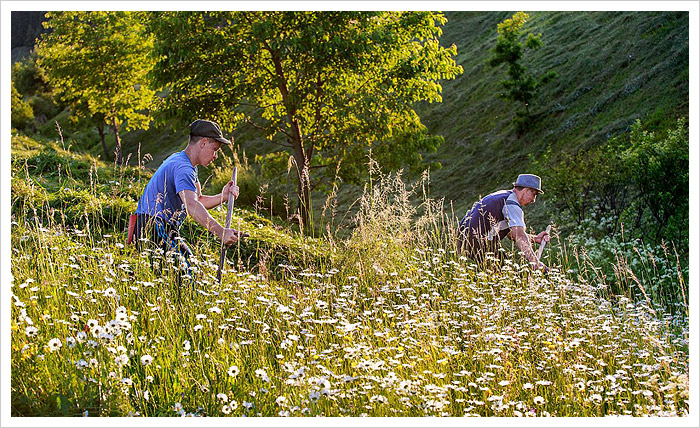
When Réka Simó, Attila's wife, who was brought up in Budapest in Hungary, first came to Gyimes, she could not believe how "people would only ever walk in single file through the meadows." It was as if, she says, "the meadows were holy ground. As though these Transylvanians were living in a world dedicated to St. Grass."
In a sense these Transylvanian farmers do live on the hay. Across the whole region, from Romanian-speaking Maramureş in the north to the ethnically Hungarian provinces in the center of the country and to villages occupied by German-speaking Saxons, the scale of their operations is essentially medieval. Millions of people in Romania work on farms, with the smallest herds, the lowest yields, some of the highest levels of self-sufficiency, and among the lowest incomes in Europe. The average farm is eight acres. More than 60 percent of the milk produced in the country comes from farmers with two or three cows, almost none of it leaving the farm where it was produced. The mathematics is both simple and tyrannical. One cow eats four or more tons of hay in winter. That amount of hay needs up to five acres of ground to grow and might take ten hot, hard days just to mow. If you're mowing alone and with a scythe, as still happens over large areas of the uplands, three cows mean a month of mowing.
But that is only the start of it. Each piece of grass must be handled ten or more times. First it is mown; then the mown stems must be raked into small heaps that don't absorb the dew; then spread again in the next day's sun to dry; then turned in the sunshine to dry the underlayers; gathered into a haystack in the field; eventually loaded onto a cart, a haystack on wheels, with the butterflies dancing up above the loaded hay; driven down the lanes to the homestead, where the horses are fed on the hay they have drawn there; unloaded at the barn into a deliciously rich-smelling heap like a dry, summer bouillabaisse; stacked high into the eaves of the barn—the chickens kicked out first so they aren't smothered under the arriving hay—where it gathers as a rustling green fabric ("it must sound right; unless it sounds right, it won't taste right") in which the flowers retain their blues and yellows and reds; then, when the winter comes and the cows are brought in from the pastures, the hay for their daily bite must be cut from the dense body of the stack and finally fed to the animals beneath in their mangers.
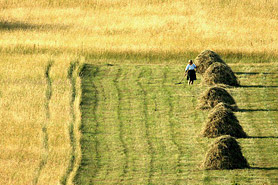
The milk of the cows in summer, when the grass in the pastures is rich, is made into soft cheeses, usually eaten at home or shared with the neighbors. Milk is also sold in the village or the nearby town. Or drunk at home. Young calves are given milk before being sold live or eaten, as the best possible meat. Very little butter is made nowadays. Instead, heart-threateningly delicious pig fat is eaten on bread. Occasionally, even the pigs are also fed on milk. By these various routes, the goodness of the grass makes its way into every corner of life.
But have no doubt: This is a world of no great riches. You can feel the hard work that keeps it going in the honed muscularity of every hand you shake, male or female. A farming family here can expect to live on around 4,000 euros ($5,235) a year, often supplemented by income from another job. Less than half of the households have bathrooms. The price of horses is high because few people can afford a car. I've sat at a dinner table where the family have discussed whether they should buy a horse or a tractor. The answer: a horse, because no one has yet invented a tractor that will give birth to another version of itself. On the other hand, you don't have to feed a tractor on the day it does no work.
During the communist years, from 1947 until 1989, the mowing regime on the high meadows was maintained. But after the revolution, which got rid of the Ceauşescus at the very end of 1989, the cooperative farms were dismantled, and lands returned to previous owners. People resumed the sort of small-scale farming they had practiced before communism, but from the mid-1990s it started to decline. Farmers got older. Young farmers thought they could make more out of arable farming or in city jobs. Milk could be bought cheaply from industrial-scale producers elsewhere. There was no sense then of the hay meadows being a rich, inherited asset.
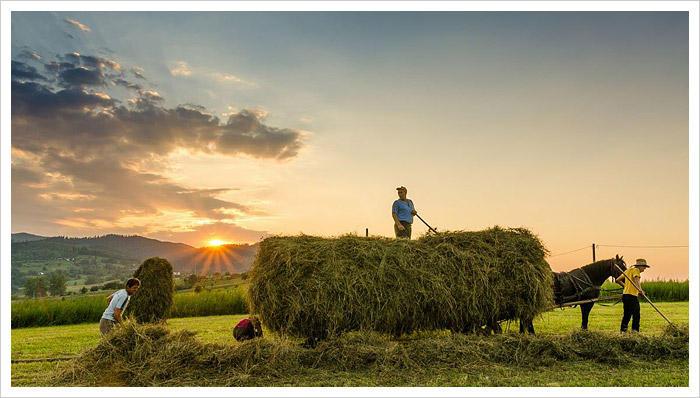
As the old farmer Vilmos Szakács from Csíkborzsova says, in Western Europe "the general approach was to leave the old things behind." Working abroad looked more tempting than staying home with the cattle and the hay. Two months' work in Norway or Sweden on construction now earns a man enough to buy a house and some land in Transylvania. As in other Transylvanian communities, animal numbers in Csíkborzsova—a charming village in the east—crashed, from 3,000 cattle and 5,000 sheep in 1990 to 1,100 cattle and 3,500 sheep in 2012. Alternative employment meant fewer animals, fewer animals meant less hay needed, and less hay needed meant unmown meadows.
The forest started to creep back into them. As the shade of the trees closed over, the meadow flowers began to disappear. "We've seen the spruce trees coming up over the ridge to the south," Rozália Ivácsony told me of her neighbor's meadows west of Csíkborzsova. "The old man died, and the young one didn't want it." Of her own grown-up family, she says, "The children come and look at the view and eat and drink and go away. We've taught all of them not to become farmers. This land"—she waved her arm slowly around her own wonderfully beautiful mown hillsides—"is useless now. No foreigners want it, and it will be abandoned."
Foreign money, earned by young men and women working abroad, began to flood into these villages. Houses that "in communist times cost six haystacks," as the farmer Gheorghe Paul from Breb, in Maramureş, told me, "now wouldn't cost less than 500 haystacks." Old wooden dwellings have been demolished or renewed. In their place have emerged large houses with microwaves on melamine counters and eye-level grills looking out on farmyards where the old world persists: chickens and turkeys pecking under the plum trees; the cow waiting patiently in her low, lightless byre; the pigs snuffling in the sty; and the grandparents bringing in the hay from the meadows.
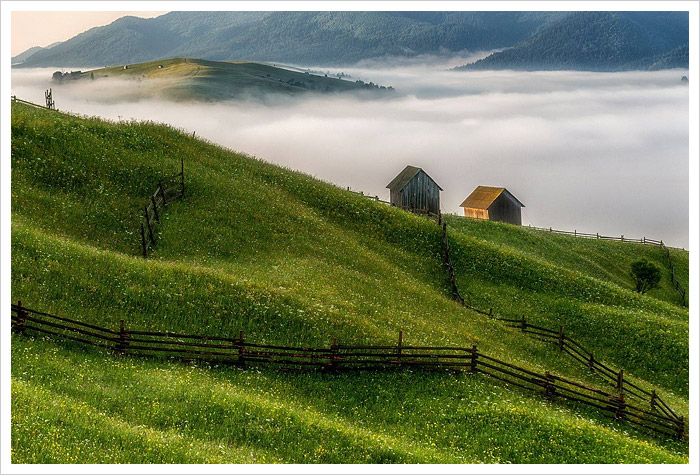
The problems were exacerbated by Romania joining the European Union in 2007. The clumsy definitions for European grant allocations prevented many small Transylvanian farms from getting European money. More than 70 percent of the intensely subdivided individual farms were too small for the Romanian bureaucrats in Bucharest even to consider them as farms. The EU says that nothing under three-quarters of an acre is an eligible plot, but most Transylvanian fields are smaller than that. Cow numbers have increased on some larger farms, but hygiene regulations designed for high-tech German and Scandinavian dairies cut into the viability of the old ways. Cottage cheese, for example, was always made in birch tubs. ("You must do everything gently," Attila Sarig told me as he kneaded the curds, "like with a girl.") The EU insisted that it be made on a stainless steel table. The traditional Transylvanian date on which to start mowing the low meadows in certain parts of Transylvania is St. John's Day, June 24, but the Romanian government set the date at July 1. Additional European subsidies are available only if the meadow is mown on or after July 1, to allow flowers to seed and young birds to mature.
As they saw their world draining away, people wanted to save it. "I want to hold on to the country my father and grandfather have made," Józef Szőcs says. And so, here and there, in small ways, they began to take control of their own lives. Local conservation organizations got to work. Milk had previously been bought from the villages by large dairy companies that ran the milk collection points and controlled the price. Starting in 2006, one or two communities, including Csíkborzsova, set up their own milk collection points, buying the storage and cooling equipment and establishing hygiene systems that conformed to EU standards. Every farmer who brought his milk in pails and buckets to the collection point was paid—but only if his milk was clean and of good quality.
Results were immediate. The milk from those Csíkborzsova farmers who had joined the new system was collected and sold separately from other milk. The price of the clean milk rose at first by 50 percent and by 2012 was three times as high as for milk from other villages. At the milk collection point in Csíkdelne, I met Jenő Kajtár one evening. Still in his blue farm overalls, he had brought in the 50 liters (13 gallons) from the five cows he had milked. Things were going well. Previously he had four cows, now he had six, and in three years the price of milk had gone up fourfold, doubling when the new milk collection point had been installed, and again when the village cooperative had set up a direct sale point in Miercurea-Ciuc, the nearby town. Fresh, unpasteurized milk was now available at an automated milk machine, filled twice a day via a refrigerated delivery truck from the village. I asked Kajtár why he thought the city folk were buying his milk. "Because it is real whole milk," he said, smiling under his mustache, "a piece of the past which their city life has left behind."
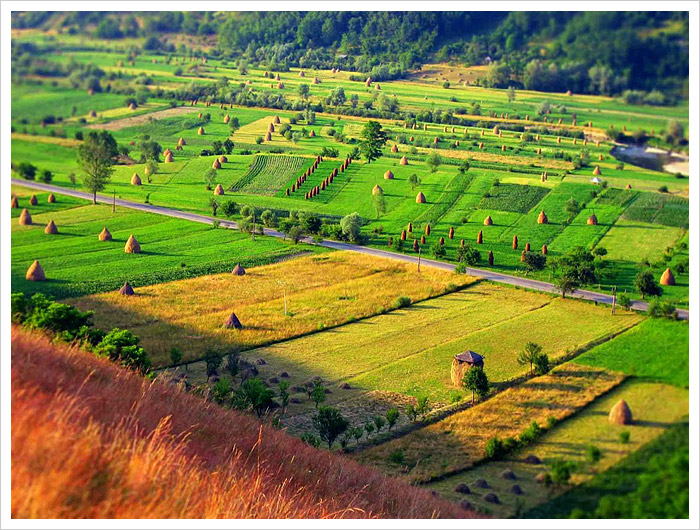
I never thought the sight of a milk-dispensing machine would move me. But here was a symbol of people trying to keep something valuable in a world whose forces were doing their best to erode and destroy it. The milk machine in Miercurea-Ciuc might, amazingly, guarantee the continued life of those flowery meadows high in the mountains above us.
The economics remain fragile. The Swiss milk dispenser costs about $13,000, and it earns about $40,000 a year, but this kind of direct sale means that if one farmer puts bad milk into the system, those buying it fall ill, trust disappears, sales collapse, and the whole village suffers. The week I was in Csíkdelne, 4 out of 22 farmers had been banned for one week because they had submitted substandard milk. One or two had been banned permanently for chronic failure to meet the required standards.
Yet in a generally diminishing market, with the higher prices, cow numbers in the milk collection villages are going up. With increasing cow numbers, the demand for hay is increasing too, and meadows that would otherwise have returned to forest are being mown again.
And the people feel some deep pride in not abandoning the beauty they've inherited. "It is our land," Anuţa Borca, a young mother from Breb, insisted to me about her family meadows. "We have to take care of it. We have to teach the children the traditions. And teach them something that allows them to survive if they have no job." She paused from the embroidery she was making on a linen shirt for her son. "It's important because tradition is a treasure. If they learn it, they will be richer."
I found another lady in Breb one day, Ileana Pop, embroidering a linen shirt for her son-in-law. Where, I asked, did the patterns come from? "Oh," she said casually, "they come from the beginning of the world. But we mix old patterns with our own ideas. We never leave the style. We just play with the style."
If only the economics could be sorted out, if only European agricultural subsidies were more attuned to local variation, if only the Romanian government were more alert to the astonishing landscape riches of Transylvania, then it might be possible to save this hay world. Transylvania is not yet a fossil. It is still alive—just—if in need of life support. But it represents one of the great questions for the future: Can the modern world sustain beauty it hasn't created itself?


